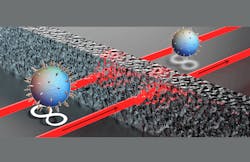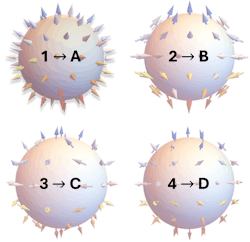Entanglement, the virtual link by which information can be exchanged across vast distances, is the cornerstone of modern quantum technologies essential for communication and computing. Unfortunately, quantum entangled states are notoriously fragile and decay when they experience a perturbation. This can be as mundane as background and stray light, noisy detectors, lost photons, or defects within materials, common effects in real-world quantum systems, which render the link useless.
How can we overcome the issue of the entanglement decaying so that information flows? The traditional approach is to try to preserve the entanglement, but so far with very limited success. Quantum computers are notoriously noisy, which is a major barrier to their scalability. Recent trends suggest topology—a branch of mathematics—might hold the answer.
What is topology?
Topology is a global, underlying property of “something,” and two “somethings” with the same topology are mathematically equivalent. A popular example is the topological equivalence of donuts and coffee mugs. At face value they look completely different, but they have the same number of holes and can be smoothly deformed from one to the other (think of stretching and squashing the donut into a coffee mug)—because they are the same in a topological sense. This is the mooted benefit of topology: An underlying feature of the system, in this example the number of holes, remains unchanged after undergoing such a deformation. Can this immutability be exploited with quantum light, too? Recent advances paved the way toward a topological alphabet, as shown below.
Quantum topological materials
One approach is to engineer materials to be topological to support topological modes. By engineering these modes as quantum states, the entanglement itself can be preserved. This has proven useful in making entanglement sources and waveguides for transport that, even with defects, do not adversely affect the entanglement of the quantum state.
A controversial recent example1,2 is the announcement by Microsoft of topological qubits using Majorana states, which claim to move fault-tolerant computing tangibly closer. By careful engineering of selected materials, they can form topological superconducting nanowires that support topological modes at their ends—collective states of the electrons within a material that are resistant to noise—and it promises preservation of quantum information. The team claims to be able to read the information out, a key ingredient to using a topological alphabet, although they are careful to say that the evidence itself is not proof that the states were topological.3
Photonic topologies
Another strategy recently mooted is to engineer the quantum state to be imbued with topology, without requiring any special materials. It has been demonstrated with photons,4 and the idea is to give the light a property that is immune to distortion so long as some entanglement exists—even a very small amount. The entangle is allowed to be fragile, but the quantum information encoded into the topology should remain intact. This holds exciting promise for information resilience in real-world systems such as global quantum networks and noisy quantum computers.
To explain how this works, think of two entangled photons, where photon A “lives” in space, while photon B “lives” in polarization. When we measure photon A, it influences the measurement outcome of the polarization of photon B by collapsing its state to some value. This is the entanglement connection between the two—colloquially explained as changing one photon affects the joint outcome with the other—even at a distance. Now, if we measure all of space for photon A, we create a complete map to all the possible polarizations of photon B, wrapping around its sphere one or more times. This wrapping is what we call topology—it’s a way of mapping one space onto another. The number of times we wrap the space is the “topological invariant.”
Recently, researchers have shown how such photonic topologies can be used to protect information against real-world sources of noise.5 The team showed that while traditional entanglement observables all decayed as the noise increased, the topological observables remained completely intact until the entanglement itself vanished. This can be seen as a form of “digitization of quantum information” made possible by the discrete nature of the topological observables, which only take on integer values. Discrete signals are always more robust against the effects of noise, which is why our classical systems today are all digital. Just as digital technology has enabled successful classical computation and communication, so too will digital quantum signals allow successful quantum computation and communication under realistic conditions without the need for compensating strategies.
This newfound understanding promises to open a path to constructing a topological toolkit: Tools for putting information into quantum light based on topology, and tools for reading the topological information out. Together they form the basis for a new topological alphabet with the promise of immutability to noise, which is essential for computation and communication by entanglement.
REFERENCES
1. D. Castelvecchi, Nature, 638, 872 (2025); https://doi.org/10.1038/d41586-025-00527-z.
2. D. Garisto, Nature, 639, 555 (2025); https://doi.org/10.1038/d41586-025-00683-2.
3. Microsoft Azure Quantum et al., Nature, 638, 651 (2025); https://doi.org/10.1038/s41586-024-08445-2.
4. P. Ornelas et al., Nat. Photonics, 18, 258 (2024); https://doi.org/10.1038/s41566-023-01360-4.
5. P. Ornelas, I. Nape, R. de Mello Koch, and A. Forbes, Nat. Commun., 16, 2934 (2025); https://doi.org/10.1038/s41467-025-58232-4.
About the Author
Andrew Forbes
Andrew Forbes is head of the Structured Light Laboratory and a distinguished professor in the School of Physics at University of the Witwatersrand (Johannesburg, South Africa).

